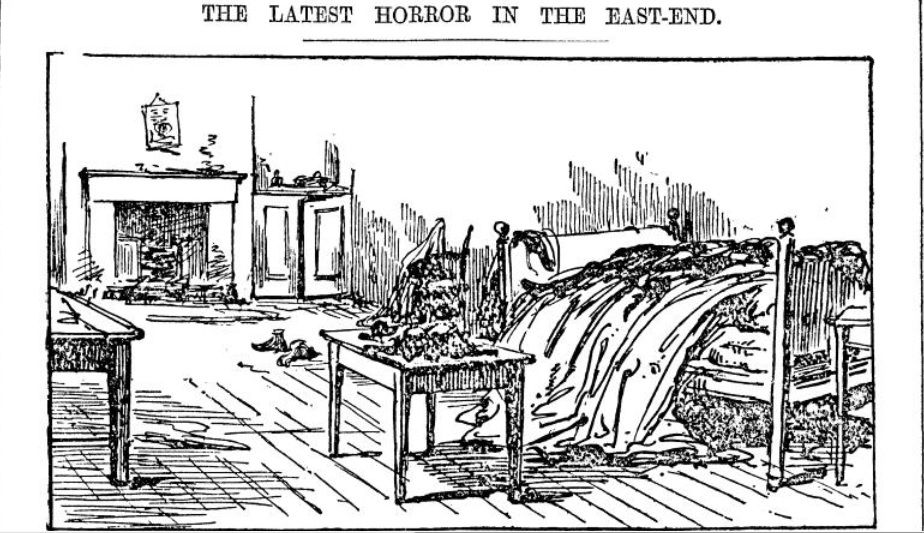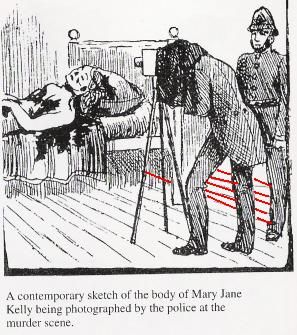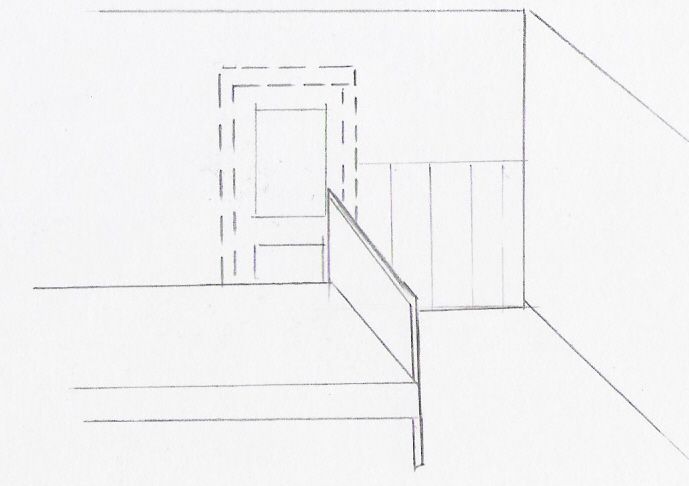Yes, I think the room was much smaller than that drawing portrays.
As for the window, yes the bricks look reasonably short but you also have to reach across that corner plus manoeuvre your limb through broken glass. Unless you had an exceptionally long arm I don't think it's do-able. Putting the door on the snib when you were out for a short while would be much easier.
Suggestion
Collapse
X
-
This makes the room look huge, so not sure how accurate it isOriginally posted by Wickerman View PostJust behind the headboard we see a stand of some kind.

Leave a comment:
-
Hello Wickerman.
You, MysTerySinGer, and Elamarma should do a dissertation. This material is great.
MysterySinger.
I cant remember who but someone posted the dimensions of the bricks. I think they were 9" long (sorry! Too lazy to convert.). So looking at the courttard photo and MJK3, a person would have only have had to reach-in a foot or lesss to open the door. It wouldprobably be easier if the break in the lower pane was high (like the shadow indicates).
Leave a comment:
-
^ I think it's a bit of 1 and 3. As has been suggested before Mary may well have left the door on the snib when she left home. After all, she had nothing of value in her home. She would lock the door and probably barricade it with a chair or table when she was alone at night. As I believe Mary brought Jack home with her (and I don't agree with Michael that she wasn't prostituting, out of desperation and hunger) she would merely have turned the knob on the door and let him in.Originally posted by MysterySinger View PostExactly my thoughts Rosella - how could they possibly reach with their hand (and not cut their arms on the broken glass for one thing)? The distance seems too great. Yet they seemed to make out it was possible.
If it's not possible to open the door from the window, then either:
1) The killer entered the room with MJK (and if Michael is correct that she didn't take clients back then it had to be a friend - someone she knew) or;
2) He had the key or;.
3) Mary didn't shut the door properly or;
4) She answered a knock on the door and was attacked or;
5) It was another woman who took a client there (and was murdered) or;
6) Pierre's theory makes sense.
More possibilities?Last edited by Rosella; 11-30-2015, 07:32 PM.
Leave a comment:
-
Yes, it looks like approx. three (in your rendition) panels of wainscoting behind the headboard, being only a small room there can't be a great deal of space, but it looks like there is something, maybe 18" or thereabouts? (just to throw a number out).Originally posted by MysterySinger View PostOr at an angle - a bit like this?
Leave a comment:
-
In the press we have a depiction of the body being photographed, I hi-lited the floorboards drawn behind the headboard, which suggests that even the artist was aware that there was a space of undetermined dimension between the headboard and the wall.
One press account places a washstand in that corner.

Leave a comment:
-
If you look careful at the 'body on the bed' photo, the wainscoting across the partition wall behind Kelly's bed, you will see that it carry's on horizontal behind the headboard. It doesn't stop at a corner, the corner of the room is further to the right just out of the picture.Originally posted by Robert St Devil View PostMysterySinger.
I cant decide if the headboard is flush up against the wall.
The position of the bed with respect to the passage wall was something like this.

Leave a comment:
-
Exactly my thoughts Rosella - how could they possibly reach with their hand (and not cut their arms on the broken glass for one thing)? The distance seems too great. Yet they seemed to make out it was possible.
If it's not possible to open the door from the window, then either:
1) The killer entered the room with MJK (and if Michael is correct that she didn't take clients back then it had to be a friend - someone she knew) or;
2) He had the key or;.
3) Mary didn't shut the door properly or;
4) She answered a knock on the door and was attacked or;
5) It was another woman who took a client there (and was murdered) or;
6) Pierre's theory makes sense.
More possibilities?
Leave a comment:
-
Yes indeed Mayerling, the Victorians were a sentimental people, as the many lachrymose paintings and drawing room ballads of the time testify.
One can imagine this song appealing to a young Irish-born woman, far away from her family and childhood haunts, even if her mother was still alive.
Leave a comment:
-
^ Mystery Singer, I've been this route before, but have you ever seen the old photo of the exterior of Mary Kelly's room which shows the windows and the distance from them to the door? Posters keep stating that Mary and friends would just have to put their arm through the broken pane to unlock the door. Yes they could, if they had arms the length of gorillas, or octopus tentacles! No, if they had normal, human-length arms.Originally posted by MysterySinger View PostThanks Michael.
So, JTR knew how to gain access to the room via the broken window and the latch on the door (and had perhaps visited there before then).
Leave a comment:
-
Hi Michael,Originally posted by Michael W Richards View PostThe point being of course that prostitutes were not in the habit of serenading anyone. There isn't one shred of evidence in existence that Mary EVER brought clients into her room, and we also have Barnett objecting to her "working the streets". Marys brothel days were behind her, and room 13 was in her own name, something rare for women without known occupations, so its entirely conceivable that this room was her place away from work...like it would seem Mary Ann Cox's may have been.
More seriously than my last couple of comments here - if, as you point out, prostitutes weren't usually singing to clients (which is a point I may question), the following occurs to me as possibilities (among many) here):
1) when Mary was heard singing she was singing to herself alone in her room.
2) unlike your point, she might occasionally sing for a client who had heard her sing somehow, and asked her to do so again.
3) that she was simply headed back to her little room, met someone in the courtyard she knew, and took him in with her - and they were so well known to each other she sang that tune to him when they were together.
Also, I am suddenly interested if anyone ever checked into the history of that tune. Certainly the lyrics seem melancholy (even forgetting their connection to a horrible crime) but their sad content is evident in many of the popular tunes of the 19th Century (like, "It's the Same the Whole World Over", or the American ballad, "After the Ball was Over"). Victorian audiences liked a good cry now and then.
Jeff
Leave a comment:
-
Nothing wrong with that idea.Originally posted by Pierre View Post
I have hypothesized that 26 Dorset Street was boarded up after the murder on Kelly.
McCarthy had at least 12 other rooms in the court, 8 x 12 might apply to those, and the press have variously sized room 13 as either 12 x 12 in one source, or 15 x 12 in another.Firstly, thanks to Rosella who writes:
“The rooms in McCarthy's rents were tiny really, 12 feet by 8 feet. You can imagine it being a bit crowded with several large policemen and the doctor inside!
No problem with that.So if there was a gate, this gate was boarded up.
12' is too narrow to be the width of a house. The 15 x 12 is more likely correct, and the 15' dimension more likely being the width, so 12' is the depth from the partition behind the bed to the window wall.Another problem with the idea of keeping costermonger barrows in the room is that, as Rosella says, the rooms were tiny. Number 26 was just the double size of number 13.
Two side by side would be sufficient, those barrows did come in different widths but the one I posted was 5ft wide from axle hub to axle hub.Wickerman also seems to be aware of the size of those barrows as he writes:
"though if you know how large a costermongers barrow was, you'd appreciate it would not fit through a front door"
So even if there was a gate, the room was small and could not keep many barrows.
Considering the number of vacant houses around Whitechapel, it is odd that the police would pay so much attention, not to mention labor & cost, just to seal up a storage 'shed' used by the man next door.And even if there was a gate, it was “securely boarded up” (The Evening Express 12 November 1888) and we have a drawing showing these boards (The Pictorial News 17 November 1888).
The Evening Express account just doesn't ring true to me. The police are not going to waste time and money sealing up a storeroom that is actually in use.
Leave a comment:



Leave a comment: